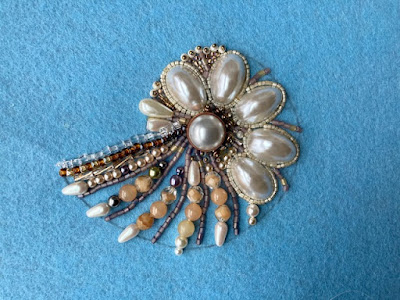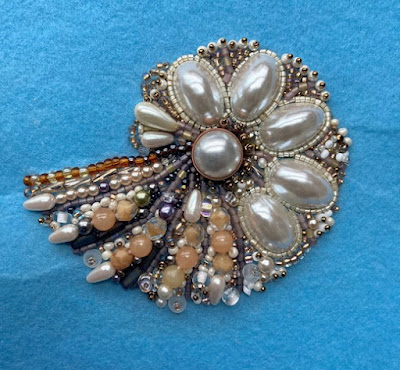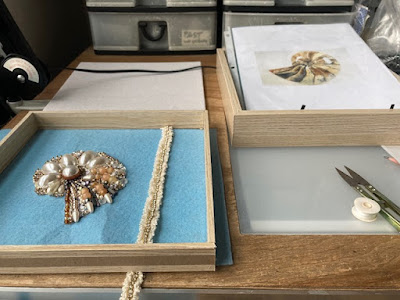This year’s Bag of Beads Challenge had a lovely cohesive
neutral theme spread across 16 ziploc bags. It was an elegant one, with unusual
pearl cabochons (stumpers), large pearls set in copper bases (it is a finding,
or a part of some fastener?), and fancy rhinestone cup chain on shaggy trim
(stumper) plus thirteen (13) more bags of beads in all shapes and sizes.
Since I prefer beadweaving, I first tried bezelling around a pearl cabochon. Not easy when you’re working in thin air and don’t have micro beads to shape a bezel to hold a flat-backed pearl. Plus how do you finish the back which no one will probably see?
Forget about my “Snowman Family” idea!
Next, I had an idea for an ammonite which would unfurl from
the center to wider chambers which I could fill in with beads. Once I started
the Google Image search for ammonites, I discovered nautilus fossils. Ammonites
are usually shown cut in half to reveal the incredible inside while nautilus
are 3-dimensional living fossils.
Fleshing out the idea — materials
I settled on Madagascar Direct’s Nautilus Fossils photo because of its graphic simplicity and coloration. I could visualize bead embroidering a nautilus using the beads in the TBS 2024 Bag. The website definition: “Nautilus fossils are the fossilized remains of ancient molluscs, a part of the cephalopod family along with octopuses, squid, and extinct ammonites.”
I printed out the nautilus photo in a few sizes to test out my idea of using the large pearl-set-in-copper in the center of the coiling and add five pearl cabochons to start the fossil spiral whorls.
Now I had a ‘Master Nautilus’ photo to refer to while bead
embroidering. I had artistic license for this Challenge, but needed reference
for the shape and shading to be realistic.
I have always admired mosaics where the artist would
incorporate unusual shapes and colors into their art and work around them. To me
glass beads are like colored pieces of inlaid stone and glass. In 2010 I took a
“Goddess Freeform Bead Embroidery Pendant” workshop with bead artist
and teacher extraordinaire, Sherry Serafini. Learning creative beading around
objects, creating textures by securing beads in different ways was a liberating
experience which stayed with me forever!
Since this was going to be a 3-D bead embroidery full of texture, I needed a stiff ground to embroider on. It needed to be a blue color to showcase the iridescent nautilus. I bought a Good Felt Bead Foundation, which was described to be “a semi-stiff foundation on which beads are sewn to create bead embroidery designs. A needle glides through it, but it is stiff enough to support your projects without hoops or card backings.” (I was disappointed in the end when the weight of my nautilus caused some ‘cracks’/folds in the foundation.)
I purchased my third 9x9 shadow box frame in a blond woodfinish from Michaels. It’s the perfect frame for 3-dimensional art because of
the depth and canvas board for pinning.
At home I pulled out my 2024 Bag of Beads along with the leftovers from the TBS 2009 Challenge. The contents were in the same ivory tones, but had a few more interesting spares, i.e. butterscotch-colored rounds and facetted glass beads with a caramel-colored core. They came in handy for stitching onto the rest of the whorls of my nautilus.
I needed to test the placement of my nautilus in the frame,
as well as figure out what I was going to do with the rhinestone cup chain
trim.
Drawing a nautilus on the blue felt
Old school methods never die!! The best way to get the main lines onto the blue felt was to make a photo copy of my master. Next, cut along the main septa (color bands) to make thin channels for a pencil to draw lines on the felt.
TIP: When cutting lines with an Exacto knife or OLFA
Multi-purpose cutter, use a self-healing mat. Press down the paper firmly as
you cut slits along the lines. Rotate the paper to allow for smooth curved
lines. STOP short so you have a stencil-like sheet without tears which you can
position on top of the foundation. Cut a second line 1/8” (2mm) away from the
first cut. Score both ends of each section and remove the paper line to reveal
the slit.
I positioned the cut-out stencil on the blue felt foundation.
I left the extra space above and below the nautilus for final tweaking in the
end after my bead embroidery was done.
Using an old-fashioned wooden pencil, I carefully traced the lines between the slits. I was able to press firmly and had full control of the drawing the line. Mechanical pencil leads would break if pressed down too hard while drawing.
Next, I sized up the ‘master inspiration’ and frame. I
connected the pencil lines on the felt for a smooth drawing. Then I reviewed
the project and figured out a plan of attack.
Start of bead embroidery
I positioned the center pearl and pearl cabochon in position on the blue felt. For the record, this is where artistic license kicks in. The pencil lines on the felt were for reference only! It was up to me to try to reimagine a nautilus using the beads and stumpers in the bag. So here’s my bead embroidery story.
Thanks to a friend, I was told E6000 glue holds cabs to felt securely, so there is no need to decrease the bezelling as in my first test sample.
The outline of each pearl cabochon is purely decorative
because the glue seal is strong after sitting to dry for 24 hours. I bead
embroidered a bezel using the cylindrical lustre-coated ivory beads around each
pearl cabochon so closely, I could not add a second or third peyote row even if
I wanted! I was satisfied with the clean single bezel outline.
Next, I used 8/o Hex beads from my stash to ‘draw’ the septa (dividing walls between chambers). I was ‘painting’ with bead colors following my Master photo reference. So, I played with matte grey, taupe and light gold Hex beads. It was interesting to note the names color assigned to the Hex beads by Miyuki because I perceived them to be as described. Color placement helped create a realistic rendition per my Master nautilus photo.
For the peristome edge where the tentacles and fine organisms
reside, I uses the tri-color assortment of 6/o seed beads in one of the TBS
bags. I carefully placed the the dark ones near the center core and lighter
ones towards the lower edge. Note the transition using three colors of beads.
For the rest of the body chamber, my Master photo showed
wider taupe-grey chambers. I used the large butterscotch beads from the
challenge along with facetted caramel-cores from TBS 2009. I needed large beads
to make the transition from the very high pearl cabs to the peristome edge.
From the mixed bag of colored pearls, I stitched down some grey pearls at
either end of the butterscotch rounds, then smaller grey ones to shape the body
chamber. The last chamber has a mix of ivory pearls and grey. Size and color
mattered.
Most of my bead embroidery was done on the sofa while
watching (listening to) television. Working in a more reclining position with a
tray of beads on my lap allowed me to take my glasses off for close-up work. I
can see better where to position the beads and insert the needle, but have to
put them back on for reference and picking up beads.
It was a constant on and off with glasses as I filled in
other beads from the bag. Some beads, i.e. yellow-lined frosted chicklets were
hidden under other bead to help create a textured shaped. The bronze-edged
twisted Corolla bugles filled in the last chamber. I also added a smaller
twisted one from my stash. I kept building the nautilus with beads of every
description from each of the bags. In the end I added the really large crow
beads with random placement on top of previous layers of texture for zing and
dimension.
I thought I was finished late one night. I am showing of my
finished Nautilus at 1:00 am.
The next morning I critically looked at my nautilus before
framing it. The super textured lower portion overtook the sweeping nautilus
whorl. I ripped off the glass triangle edge by the peristome edge. Then I
proceeded to carefully add smaller ivory seed beads, metallic bronzes and
stitching brass-lined crystal AB 10/o, 8/o and occasional 6/o seed beads to
extend and shape the top pearl cabochon whorls. A few glass triangle on top
added sparkle. In the end, I am satisfied with my bead embroidered nautilus.
Time to frame and deal with elephant in the room, the fuzzy rhinestone cup chain trim. This required figuring the best position for my beaded nautilus and where exactly the trim should be. Careful pencil guides marked where to cut off the excess blue felt and stitch the cup chain.
Following my penciled line, I stitched down the cup chain
trim carefully by coming up between the rhinestone cups. This underlined the
nautilus and took care of the requirement of using everything in the Bag of
Beads.
Rechecked the positioning of my nautilus and cut off the excess blue felt. I used some E6000 glue again to hold the heavy bead embroidery to the back board and attempted to press down the felt fold ‘cracks’. To try to flatten out the background, I added a few thin pins into the folds. Thank goodness the shadow box frame come with a canvas board one can pin into!
Here I am pleased I completed the 2024 Bag of Bead Challenge and have a third shadow box Nautilus to add to my bead room gallery along with 2023 Mid Century Modern and 2023 Secret Garden.
























No comments:
Post a Comment